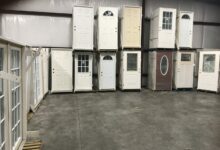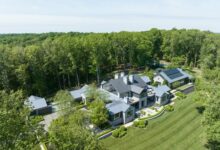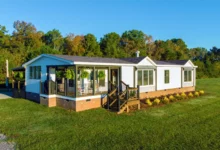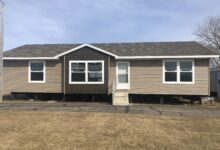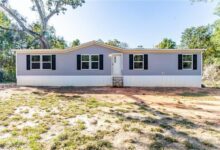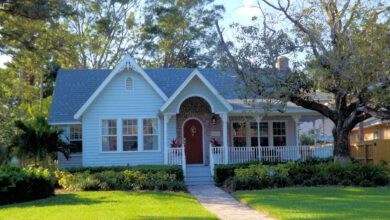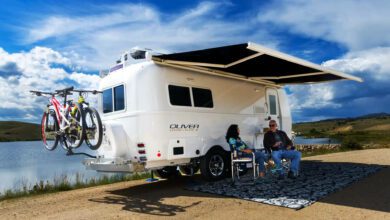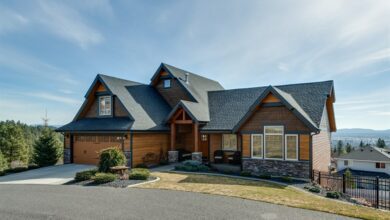Prefab Homes for Sale in California: Guide to Modern Living
Prefab Homes for Sale in California – Looking for a unique and sustainable housing solution in the Golden State? Look no further than prefab homes for sale in California. These innovative dwellings have been gaining popularity in recent years, offering an affordable and eco-friendly option for homeowners. In this comprehensive guide, we’ll explore everything you need to know about prefab homes in California, from the benefits they offer to the top manufacturers and the process of buying one. So, let’s dive in and discover the future of modern living!
What are Prefab Homes?
When it comes to prefab homes, there are various types to consider. One popular option is modular homes, which are constructed in sections or modules in a factory setting. These modules are then transported to the building site and assembled together to create the final home. Another type is panelized homes, which consist of pre-built wall panels that are manufactured off-site and then delivered to the site for installation. Lastly, manufactured homes are built entirely in a factory and then transported to the site.
Modular Homes
Modular homes are known for their flexibility and customization options. The modules are built off-site, allowing for precision and efficiency in construction. These homes can be easily expanded or modified in the future, making them a great choice for growing families or individuals who desire flexibility in their living space.
Panelized Homes
Panelized homes offer a faster construction process compared to traditional stick-built homes. The wall panels are built in a factory setting, ensuring high-quality construction and reducing the chance of weather-related delays. Once the panels are delivered to the site, they are assembled quickly, saving time and labor costs.
Manufactured Homes
Manufactured homes, also known as mobile homes, are built entirely in a factory and then transported to the site. These homes are built to the Department of Housing and Urban Development (HUD) code, ensuring they meet specific safety and quality standards. Manufactured homes are an affordable housing option and are often placed in mobile home parks or communities.
The Benefits of Prefab Homes in California
California is known for its unique environmental concerns, including earthquakes and wildfires. Prefab homes offer several advantages that make them ideal for the state’s climate and sustainability goals.
Energy Efficiency
Prefab homes are designed with energy efficiency in mind. They often come with high-quality insulation, energy-efficient windows, and appliances, reducing energy consumption and lowering utility bills. Additionally, many prefab home manufacturers offer solar panel options, allowing homeowners to harness the abundant California sunshine for clean and renewable energy.
Sustainability
Prefab homes are an environmentally friendly housing option. The off-site construction process minimizes waste, as materials can be recycled and reused in the factory. Furthermore, prefab homes can be designed with sustainable features such as rainwater harvesting systems, green roofs, and low-flow plumbing fixtures, reducing water consumption and promoting a greener lifestyle.
Resilience to Natural Disasters
California is prone to earthquakes and wildfires, making the resilience of homes a top priority. Prefab homes are constructed with durable materials and engineering techniques that enhance their ability to withstand seismic activity. Additionally, these homes can be designed with fire-resistant materials and features, providing an added layer of protection against wildfires.
Top Prefab Home Manufacturers in California
When it comes to prefab homes, California is home to some of the top manufacturers in the industry. These manufacturers offer a wide range of designs, materials, and pricing options to cater to different preferences and budgets.
Company A
With a focus on modern and sustainable designs, Company A offers a variety of customizable prefab homes. Their homes feature open floor plans, high ceilings, and large windows to maximize natural light. They use eco-friendly materials and energy-efficient systems, ensuring a green and comfortable living space.
Company B
Company B specializes in modular homes that combine style and affordability. They offer a range of floor plans to choose from, allowing homeowners to personalize their living space. Their homes are known for their quality construction and attention to detail, making them a popular choice among those seeking a balance between cost and design.
Company C
Company C is renowned for its luxury prefab homes that exude elegance and sophistication. Their homes feature high-end finishes, premium appliances, and cutting-edge technology. With a focus on customization and craftsmanship, Company C provides an upscale living experience for those looking for a truly unique and luxurious home.
Financing and Insurance for Prefab Homes
Securing financing and insurance for prefab homes in California requires some specific considerations. While the process may differ slightly from traditional stick-built homes, there are options available to ensure a smooth and successful purchase.
Financing Options
When it comes to financing a prefab home, there are a few options to explore. One option is to obtain a construction loan, which provides funds to cover the cost of building the home. Once the home is completed, the loan can be converted into a traditional mortgage. Another option is to seek a specialized loan for prefab homes, which may have different requirements and terms compared to conventional mortgages. It’s essential to research and compare different lenders to find the best financing option for your specific needs.
Insurance Considerations
Insuring a prefab home in California is similar to insuring a traditional home. However, it’s crucial to inform insurers that the property is a prefab home to ensure proper coverage. Some insurers may have specific requirements or concerns regarding prefab homes, so it’s essential to work with an insurance provider experienced in insuring these types of properties. Additionally, it’s recommended to consider additional coverage for natural disasters, such as earthquakes or wildfires, which are common concerns in California.
The Process of Buying a Prefab Home
Purchasing a prefab home in California involves several steps to ensure a successful and enjoyable experience. From selecting a location to overseeing the installation process, here’s a breakdown of the buying process.
Step 1: Choosing a Location
The first step in buying a prefab home is selecting a location. Consider factors such as proximity to amenities, transportation, and the community’s overall vibe. Additionally, ensure that the chosen location complies with local zoning regulations and permits the installation of prefab homes.
Step 2: Designing Your Home
Designing your prefab home involves selecting a floor plan, choosing finishes and materials, and customizing the layout to suit your needs. Work closely with the manufacturer or a design professional to create a home that reflects your style and preferences.
Step 3: Obtaining Permits
Before the construction process can begin, it’s crucial to obtain the necessary permits and approvals from the local authorities. This ensures that your prefab home complies with building codes and regulations specific to your location.
Step 4: Construction and Installation
Once the permits are in place, the construction process can begin. The modules or panels are fabricated off-site, ensuring quality and precision. They are then transported to the site and assembled, with electrical, plumbing, and HVAC systems being connected. The installation process usually takes a few weeks, depending on the complexity of the design and site conditions.
Step 5: Inspections and Final Touches
After the installation is complete, the home undergoes inspections to ensure compliance with building codes and safety standards. Once the inspections pass, any final touches, such as landscaping or interior finishes, can be added to complete the home.
Step 6: Move-In and Enjoy
Once all the necessary steps are completed, it’s time to move into your new prefab home and enjoy the modern and sustainable living it offers. Settle in, personalize your space, and embrace the benefits of prefab homeownership in California.
Cost Comparison: Prefab Homes vs. Traditional Homes
When deciding between a prefab home and a traditional stick-built home in California, it’s essential to consider the cost implications. While prefab homes often offer cost-saving advantages, it’s crucial to evaluate the overall expenses associated with both options.
Construction Costs
One advantage of prefab homes is the potential cost savings in construction. The controlled factory environment allows for efficient production and reduced labor costs. Additionally, the ability to customize and choose from various designs can help homeowners find a prefab home that suits their budget without compromising on quality or style.
Maintenance and Energy Bills
Prefab homes are often designed with energy-efficient features, such as insulation and energy-efficient windows, which can result in lower energy bills over time. Additionally, many prefab homes offer the option to incorporate sustainable technologies like solar panels, further reducing energy costs. When it comes to maintenance, prefab homes are typically built with high-quality materials that require less maintenance compared to traditional homes. This can translate into long-term cost savings and less time spent on repairs and upkeep.
Resale Value
Another aspect to consider is the resale value of prefab homes compared to traditional homes. With the increasing popularity of sustainable and modern living, prefab homes are gaining recognition and appeal among homebuyers. As a result, prefab homes in desirable locations can hold their value or even appreciate over time. It’s important to research the real estate market in your area and consult with experts to understand the potential resale value of prefab homes in your chosen location.
Considerations for Traditional Homes
While traditional stick-built homes offer their advantages, they can also come with higher construction costs and longer build times. Customization options may be limited, and the process can be more labor-intensive, leading to increased expenses. Additionally, the maintenance and energy costs of traditional homes may be higher, especially if they are older or not built with energy-efficient features.
Overall Cost Considerations
When comparing the costs of prefab homes and traditional homes in California, it’s essential to consider the overall expenses involved. While prefab homes may have lower construction costs and energy bills, factors such as land acquisition, permits, and site preparation should be taken into account. Additionally, the specific design, size, and finishes of the home can influence the final cost. It’s advisable to work closely with prefab home manufacturers and builders to get accurate cost estimates and understand the potential savings and expenses associated with each option.
Green Living: Sustainability Features of Prefab Homes
One of the significant advantages of prefab homes is their focus on sustainability and green living. These homes are designed to minimize environmental impact and promote a more eco-friendly lifestyle. Here are some sustainable features commonly found in prefab homes:
Energy-Efficient Design
Prefab homes are often designed with energy efficiency in mind. They incorporate features such as optimal insulation, energy-efficient windows, and doors to minimize heat loss or gain. Additionally, the placement of windows and skylights is strategically planned to maximize natural light and reduce the need for artificial lighting during the day.
Solar Power
Many prefab homes offer the option to include solar panels as part of their design. Solar power is a clean and renewable source of energy that can significantly reduce reliance on traditional power grids. By harnessing the abundant sunshine in California, homeowners can generate their electricity and lower their carbon footprint.
Water Conservation
Prefab homes often incorporate water-saving features to promote water conservation. These may include low-flow plumbing fixtures, dual-flush toilets, and rainwater harvesting systems. Rainwater harvesting systems collect rainwater from the roof, which can then be used for irrigation or other non-potable purposes, reducing reliance on municipal water supplies.
Recycled and Sustainable Materials
Prefab homes prioritize the use of sustainable and recycled materials wherever possible. This can include materials such as reclaimed wood, recycled steel, or eco-friendly insulation made from recycled materials. By reducing the demand for new resources, prefab homes contribute to the preservation of natural resources and the reduction of waste.
Green Roofs and Living Walls
Some prefab homes incorporate green roofs or living walls into their design. Green roofs are covered with vegetation, providing insulation, reducing stormwater runoff, and improving air quality. Living walls, also known as vertical gardens, bring nature indoors and enhance the aesthetics while improving air quality and providing additional insulation.
Smart Home Technology
Many prefab homes embrace smart home technology, allowing homeowners to monitor and control energy usage. Smart thermostats, lighting systems, and energy monitoring devices enable homeowners to optimize energy consumption, reduce waste, and lower utility costs.
Lifecycle Assessment
Prefab homes often undergo a lifecycle assessment, which evaluates the environmental impact of a home from production to disposal. This assessment helps identify areas where further improvements can be made to enhance the overall sustainability of prefab homes.
Designing Your Dream Prefab Home
One of the exciting aspects of choosing a prefab home is the ability to customize and design your dream living space. Whether you prefer a contemporary, minimalist style or a more traditional aesthetic, prefab homes offer endless design possibilities. Here are some considerations to keep in mind when designing your prefab home:
Layout and Floor Plans
Consider your lifestyle and how you envision using the space when selecting a floor plan. Think about the number of bedrooms, bathrooms, and common areas that would suit your needs. Open floor plans are popular for their spaciousness and flexibility, while designs with separate rooms offer more privacy and defined spaces.
Interior Finishes
Choose finishes that reflect your personal style and create the ambiance you desire. Consider options such as flooring materials, cabinetry, countertops, and paint colors. Explore different textures, colors, and patterns to add depth and personality to your interior space.
Outdoor Living Spaces
Don’t forget to incorporate outdoor living spaces into your design. Whether it’s a spacious patio, a rooftop terrace, or a cozy backyard, make sure to create areas where you can enjoy the beautiful California weather and landscape. Consider features like outdoor kitchens, fire pits, or gardens to enhance your outdoor living experience.
Sustainability Features
If sustainability is important to you, discuss options with your prefab home manufacturer to incorporate eco-friendly features. This may include energy-efficient appliances, sustainable flooring materials, or low VOC paints. You can also explore the possibility of incorporating renewable energy systems, such as solar panels, into your design.
Flexibility and Adaptability
Prefab homes offer flexibility and adaptability, allowing you to customize your living space according to your current and future needs. Consider incorporating features that can easily be modified, such as movable partitions or convertible rooms, to accommodate changing circumstances or lifestyle preferences.
Architectural Style
Explore different architectural styles to find the one that resonates with your taste and complements the surrounding environment. Whether you prefer modern, traditional, rustic, or a fusion of styles, there are prefab home designs available to suit your preferences.
Lighting and Natural Ventilation
Take advantage of natural light and ventilation in your design. Consider the placement of windows, skylights, and glass doors to maximize daylight and airflow. This not only enhances the overall aesthetic appeal but also helps reduce the need for artificial lighting and mechanical cooling systems.
Storage Solutions
Storage is an essential aspect of any home design. Consider incorporating built-in storage solutions to maximize space and keep your home organized. From closet systems and shelving units to hidden storage compartments, there are various options to ensure your prefab home meets your storage needs.
Outdoor Integration
When designing your prefab home, think about how it integrates with the outdoor environment. Incorporate large windows or glass doors to create a seamless connection between indoor and outdoor spaces. This not only enhances the aesthetics but also allows for better views and natural ventilation.
Working with Design Professionals
Don’t hesitate to consult with design professionals, such as architects or interior designers, who have experience working with prefab homes. They can provide valuable insights, suggest innovative design solutions, and guide you through the process of creating your dream prefab home.
Prefab Home Communities in California
Living in a prefab home community offers a unique sense of community and shared amenities. These communities are becoming increasingly popular in California, catering to individuals and families seeking a modern and sustainable living experience. Here are some notable prefab home communities in the state:
Community A
Located in a scenic coastal area, Community A offers a range of prefab homes with stunning ocean views. The community features shared amenities such as a clubhouse, swimming pool, and walking trails. Residents can enjoy a relaxed coastal lifestyle while being part of a vibrant and close-knit community.
Community B
Situated in a bustling urban neighborhood, Community B offers a blend of modern design and city living. The community boasts rooftop gardens, communal workspaces, and fitness centers. Residents can enjoy the convenience of city life while being part of a sustainableand environmentally conscious community.
Community C
Nestled in the heart of California’s wine country, Community C offers a picturesque setting for prefab home living. Surrounded by vineyards and rolling hills, the community provides residents with access to shared gardens, wine tasting rooms, and community events. It’s a perfect place for wine enthusiasts and those seeking a peaceful and scenic lifestyle.
Community D
Community D is a family-oriented prefab home community located in a suburban area. The community features playgrounds, sports courts, and community centers, providing ample opportunities for families to connect and engage in outdoor activities. The proximity to schools, shopping centers, and parks makes it an ideal choice for families looking for a close-knit community with convenient amenities.
Community E
For those seeking an eco-friendly and sustainable lifestyle, Community E is a standout option. This community is designed with sustainability in mind, featuring green spaces, community gardens, and shared composting areas. Residents can participate in educational programs and workshops on sustainable living, fostering a strong sense of environmental stewardship within the community.
Community F
Community F is a vibrant and diverse prefab home community located in an urban setting. With a focus on inclusivity and community engagement, this community offers shared amenities such as community centers, art studios, and performance spaces. Residents can connect with neighbors through various social and cultural activities, creating a lively and dynamic living environment.
Community G
Located in a serene mountainous region, Community G offers a tranquil escape from the hustle and bustle of city life. Surrounded by nature, residents can enjoy hiking trails, community parks, and outdoor recreational activities. The community fosters a strong connection with the natural environment, allowing residents to embrace a sustainable and nature-centric lifestyle.
Community H
Community H is a senior-focused prefab home community designed to cater to the unique needs and preferences of older adults. The community offers accessible amenities, wellness programs, and social activities specifically tailored for seniors. It provides a supportive and engaging environment for retirees looking for a vibrant and active retirement lifestyle.
Community I
Community I is an innovative and forward-thinking prefab home community that prioritizes sustainable technologies and smart home features. The community incorporates renewable energy systems, electric vehicle charging stations, and advanced home automation systems. It serves as a living laboratory for sustainable living, inspiring residents to embrace a greener and more connected lifestyle.
Community J
Situated in a rural setting, Community J offers a peaceful and close-knit living environment. The community emphasizes self-sufficiency and sustainable practices, with residents participating in shared farming and gardening initiatives. It’s an ideal choice for those seeking a simpler and more communal way of life, surrounded by nature and like-minded individuals.
These prefab home communities in California provide residents with the opportunity to live in a sustainable and supportive environment. Each community offers unique amenities, designs, and lifestyles, catering to different preferences and needs. Whether you’re looking for a coastal retreat, an urban oasis, or a nature-centric lifestyle, there’s a prefab home community in California to suit your desires.
The Future of Prefab Homes in California
The future of prefab homes in California is promising, with continued growth and innovation in the industry. As sustainability becomes increasingly important and housing affordability remains a challenge, prefab homes offer a viable solution. Here are some trends and developments shaping the future of prefab homes in California:
Advancements in Technology
Technological advancements continue to revolutionize the prefab home industry. From improved construction techniques to enhanced energy-efficient systems, technology plays a crucial role in making prefab homes more sustainable, cost-effective, and customizable. The use of virtual reality and 3D modeling allows homeowners to visualize their homes before construction, ensuring a seamless and personalized experience.
Integration of Smart Home Features
Smart home technology is becoming increasingly integrated into prefab homes. From energy management systems to automated lighting and security features, homeowners can control and monitor various aspects of their home remotely. This integration not only enhances convenience but also contributes to energy efficiency and sustainable living.
Expansion of Design Possibilities
Prefab homes are no longer limited to simple and minimalist designs. Manufacturers are expanding their design options to cater to a wide range of architectural styles and aesthetic preferences. From contemporary and modern designs to traditional and rustic styles, homeowners now have more choices to create their dream homes.
Incorporation of Sustainable Materials
The use of sustainable materials is gaining momentum in the prefab home industry. Manufacturers are exploring eco-friendly alternatives to traditional building materials, such as recycled steel, bamboo, and reclaimed wood. This shift towards sustainable materials not only reduces the environmental impact but also enhances the overall quality and durability of prefab homes.
Emphasis on Energy Efficiency
Energy efficiency remains a top priority in the design and construction of prefab homes. Manufacturers are continually improving insulation, HVAC systems, and energy-efficient appliances to reduce energy consumption and lower utility costs. The integration of renewable energy systems, like solar panels and geothermal heating, is also becoming more common, enabling homeowners to generate their energy and reduce reliance on the grid.
Expansion of Prefab Home Communities
Prefab home communities are expected to expand in California. As demand for sustainable and affordable housing grows, developers are recognizing the benefits of creating planned communities specifically designed for prefab homes. These communities offer shared amenities, a sense of belonging, and a supportive environment for residents to embrace modern and sustainable living.
Government Support and Incentives
The government’s focus on sustainability and affordable housing is likely to result in increased support and incentives for prefab homes. Initiatives promoting sustainable building practices, such as tax credits for energy-efficient homes and streamlined permitting processes, can further encourage the adoption of prefab homes in California.
Collaboration and Partnerships
Collaboration and partnerships between prefab home manufacturers, architects, and builders are expected to increase. These collaborations foster innovation, creativity, and the exchange of ideas, leading to the development of more efficient and sustainable prefab home solutions. By working together, industry professionals can continue to push the boundaries of design, technology, and sustainability in prefab homes.
The future of prefab homes in California is bright, with an increased focus on sustainability, technology, and design. As the demand for affordable and eco-friendly housing options continues to rise, prefab homes are poised to play a significant role in shaping the future of modern living in the Golden State.
